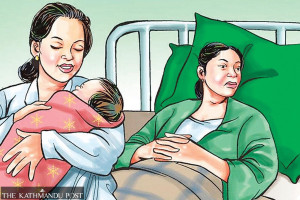Opinion
An emerging epidemic
What will be the biggest threat to Nepal’s economy in the next century? Will it be the threat of external aggression from a neighbouring country, the recurrence of an earthquake, or political upheaval? In my view, hypertension will be the biggest threat.
Dr Manoj Bhattarai
What will be the biggest threat to Nepal’s economy in the next century? Will it be the threat of external aggression from a neighbouring country, the recurrence of an earthquake, or political upheaval? In my view, hypertension will be the biggest threat. A study of 2,815 adult participants in western Nepal published in May 2017 in the American Journal of Hypertension shows the prevalence of hypertension at 28 percent. This figure is in congruence with earlier reports from studies conducted in different geographic locations in Nepal. While this data broadly aligns with the global prevalence of hypertension of approximately 30 percent, emerging concerns stem from smaller studies reporting soaring incidences of hypertension in Nepal related to prolonged life expectancy and an upsurge in obesity.
Awareness about hypertension and its treatment is dishearteningly low in most places of Nepal. According to a survey by the Nepal Health Research Council in 2014, roughly 90 percent of cases go untreated in spite of diagnosis. Sadly, fewer than half of those receiving treatment achieve adequate blood pressure control. The resulting uncontrolled hypertension is linked to premature kidney failure, stroke, cardiovascular disease, disability and overall mortality. Notably, mainstream media, health care providers, policy holders and major political groups have turned a blind eye to the worrisome consequences of hypertension.
This article underscores the strategies and policies related to following target groups and areas of intervention that Nepal’s federal structure can undertake to curb the disastrous aftereffects of deficient and ineffective blood pressure (BP) control.
Detection of new cases
Several studies have reported low awareness of hypertension in Nepal due to low literacy levels and inadequate access to medical care. Hypertension raises the risk of cardiovascular disease and stroke, which are among the highest causes of adult mortality in Nepal. Studies prove that hypertension starts at an early age and worsens as individuals age. Therefore, screening should begin in high school and increase in frequency during adulthood.
The new local government should shed the spotlight on strategic approaches to detect hypertension. BP screening during the application for citizenship and renewal of drivers’ licenses, instalment of automated BP machines in airport boarding areas, offering free BP check-ups in village wards and major shopping malls are all strategies that could be implemented. Similarly, BP measurement before applying for foreign employment, and awareness programmes in schools and through mainstream media could prove critical. Early detection can lead to early lifestyle adjustment.
Cultural beliefs about the disease and efficacy of treatment, lack of robust social support, high cost of medication, gender disparity and poor doctor-patient relationships seem to underline the failure by hypertensive patients to take medication. Depression, psychological stress, lack of motivation and inadequate education about the disease and medication are also patient-related factors. Interventions to increase adherence in such circumstances may include peer and family assistance in disease management, closer involvement of community-based organisations and mobilisation of female community health volunteers. Another approach would be to replicate a treatment strategy used in nursing tuberculosis patients where someone observes a patient taking medication to foster adherence.
Continuous monitoring
Inadequate BP control may result from non-adherence to medication intake, insufficient dosage and/or number of medications, and excess salt intake. Complexity of therapy and unwanted side effects also increase non-compliance. Failure to stick to medical therapy increases medical costs and hampers overall quality of medical care. The risk perception, cognitive functioning, health literacy, motivation for self-care and family support help determine the consistency of medication adherence.
Furthermore, simplifying the treatment regimen, telephone follow-ups, text-messaging, family or phone reminders, home visits by local health staff and patient education by clarifying their lay beliefs about health and treatment play a pivotal role in achieving a positive impact. Technology assisted self-management intervention may include telemedicine, telemonitoring, web-based interventions, and prompts for appointment reminders.
Continuous monitoring and reassessment of treatment by physicians is key. Physicians should prioritise mutual goal setting, empowering patients by active engagement and participation, quality improvement strategies, and care coordination. Instructions should be limited to three to four major points during each encounter and oral teaching should be supplemented with materials written in simple everyday language for patients with low literacy skills.
Government measures
Public education campaigns and multi-pronged strategies related to tobacco control, alcohol limitation, dietary adjustment, physical activity and weight reduction should be implemented through collaborative efforts at local levels for timely screening and diagnosis, treatment and control of blood pressure. The prevalence of smoking—a major risk factor for cardiovascular mortality—in Nepali women is the highest in South Asia. The Smoking (Prohibition and Control) Act was first drafted in 2001, and since then taxation on tobacco products, partial ban on tobacco advertising, smoking-free public areas, inclusion of tobacco’s ill-effects in school curricula and training programmes have been implemented, albeit ineffectively due to weak regulatory mechanisms.
Recently, the Nepal government endorsed the “National Policy on Regulation and Control of Alcohol-2017” mandating that more than 75 percent of the pictorial display on the bottle should warn of the ill effects, barring pregnant women and those under 21 from purchasing alcohol, and placing restrictions on advertising and sales. While these are steps in the right direction, their success hinges on rigorous implementation and regulation.
Consumption of a diet rich in fruits and vegetables and low-fat dairy products, with a reduced content of saturated and total fat, has been shown to help prevent hypertension. Promotion of heart-healthy lunch menus in office and school cafeterias is necessary through comprehensive collaborative campaigns. Offering tax subsidies to encourage the opening of farmer’s markets, supermarkets and restaurants with heart-healthy diets, gym halls, accessible parks, bike paths and walking trails could also provide a turning point in the fight against hypertension.
The Nepal government should collaborate with professional associations, policy developers and food industry experts to increase the availability of low-sodium food products and to offer educational programmes regarding portion size, heart-healthy food choices and physical activity. Buying of ready-made and processed foods should be disincentivised. Nepal Food Act 1966 prohibits selling of food though misleading activities, but it should be revised to emulate and incorporate successful dietary policies of developed countries like Finland’s tax on sweets and soft drinks,
France’s tax on sugar and artificially-sweetened beverages and Iceland’s policy of promoting supply of fish like salmon and herring. The government should seek the expertise of registered dieticians and food technologists, and lobby local pharmaceuticals to produce inexpensive generic hypertension drugs.
Additionally, investing in surveillance, research and evaluation, fostering targeted training of general practitioners and empowering primary health care providers through health education and promotion would be helpful. South Africa exemplifies such a model where a nurse-led clinical protocol in primary care clinics controlled hypertension in 68 percent of patients. All in all, creating awareness for early detection, and controlling and treating hypertension are critical public health measures that would help stem the tide of the emerging epidemic.
Bhattarai is a practising nephrologist in West Palm Beach, Florida, US; he is also a geriatrician




 10.12°C Kathmandu
10.12°C Kathmandu











